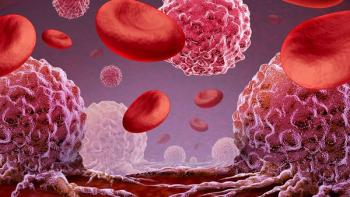
- CURE® Summer 2022
Uncovering New Ways to Make Cancer Surgery Safer
The use of newer tools and techniques may be reducing the risk of surgical site infections and other complications in patients receiving treatment for gynecologic cancers.
When Nancy Tellez, 37, received a cervical cancer diagnosis in 2019, her oncologist was confident the surgery to treat the cancer would have no complications because Tellez was young and healthy.
Her cervix, uterus and a portion of her vagina were removed during a radical hysterectomy, and she was told to expect some discomfort during recovery after discharge from the hospital.
The pain in her pelvis worsened when she returned home, but Tellez, of Topeka, Kansas, assumed the throbbing was normal after surgery. During the following four days, her right pelvis became swollen, fluid started leaking out of her vagina and her level of discomfort surpassed labor pains. She also had a temperature of 104 degrees.
A friend rushed Tellez to the emergency room, where a CT scan showed a mass in her pelvis. During a second surgery, doctors drained the abscess.
The last thing Tellez remembered that day was shaking because she felt extremely cold in the recovery room, and then she lost consciousness.
She went into septic shock due to an infection, and she awoke briefly at one point as a priest was reading her last rites. Tellez was treated with antibiotics and regained consciousness several days later, when doctors explained that she was lucky to be alive.
The infection was likely caused by urine leaking from a tear in her urethra. She also developed Clostridioides difficile (an infection commonly known as C. diff that can cause severe diarrhea and inflammation of the colon) while in the hospital, possibly as a result of the antibiotics.
Although Tellez eventually recovered and is grateful that her cancer is in remission, she wishes she had understood the risk of infection before undergoing surgery.
“The doctor briefly touched on one or two potential complications, but nothing about the risk of infection,” she says. “I had so many medical bills related to the complications, and I was going through a divorce and raising four children.”
Surgery is a part of treatment for many patients diagnosed with gynecologic cancer, which includes uterine, ovarian, cervical, vaginal and vulvar cancers.
“Infections after surgery are a problem in the United States and worldwide,” says Dr. Oliver Zivanovic, director of innovative surgical technology at Memorial Sloan Kettering Cancer Center in New York City. “I’m taking care of patients with gynecologic cancer who are already suffering from a complex disease, and it’s important to try to minimize the risk of infections for these patients.”
The surgeries range from laparotomy — a large incision in the abdomen — to minimally invasive procedures such as a laparoscopy (use of a thin, lit tube with a video camera administered via a small incision) or robotic approaches to vulvar and vaginal procedures involving removal of tissue in a localized area.
The risk of infection is lower with early-stage disease that can be treated with minimally invasive surgery, but women with advanced cancer are usually not candidates for laparoscopic or robotic procedures, says Zivanovic.
“I see many older patients who present with metastatic ovarian or uterine cancer who require large incisions, long operative times and blood transfusions, and all these factors increase the risk of infection,” he says.
Studies have shown that patients with gynecologic cancer who require a bowel resection (the removal of some or all of the large intestine) during surgery are at highest risk of surgical site infection (SSI), with rates ranging from 33% to 37% in recent studies. Patients may also have comorbidities, such as poorly controlled diabetes, obesity or compromised immune systems, that can elevate the chance of developing an infection, according to Zivanovic.
Infections may increase the length of stay in the hospital and the chance of needing additional interventions such as a repeat surgical procedure — and elevate the risk of death by as much as elevenfold.
Although infection after surgery is a complex problem, researchers are exploring strategies to reduce the risk of this complication.
“In gynecologic oncology, many researchers and surgeons are working to discover ways to make surgery safer,” says Dr. Amanda Nickles Fader, a professor of gynecology/obstetrics and oncology and vice chair of gynecologic surgical operations at Johns Hopkins Health System in Baltimore. “These strategies help patients experience a better recovery and transition more quickly to further cancer treatments, if needed.”
Success With Interventions
Nickles Fader and colleagues previously studied the outcomes of more than 200 women who underwent cytoreductive surgery (a procedure to remove tumors in the abdominal cavity) for ovarian cancer, and the results demonstrated that a “bundle” of infection prevention strategies reduced SSIs from 20% to 3%, and the hospital readmission rate dropped from 13% to 3%.
The strategies included the use of a sterilizing soap known as chlorhexidine, which the patients applied at home before surgery and the medical team used during the surgery.
Patients in the bundle group also received antibiotics prior to surgery, and those requiring bowel resection were prescribed laxatives the night before to clear the colon. During especially prolonged surgeries, patients received antibiotics during the procedure, and those undergoing colon resection received broader-spectrum antibiotics that acted on a wider range of bacterial types.
“Communication between the surgery, anesthesiology and nursing teams is critical during surgery to keep the patient safe,” explains Nickles Fader.
Before closing abdominal incisions in patients who underwent colon resection, the operating team changed gloves, gowns and medical instruments to avoid using surgical tools that could be contaminated with bacteria from the colon. In surgeries involving colon resection, these safety measures reduced the rate of infection from 33% to 7%.
While many hospitals are leveraging these strategies to minimize infections, not all are, notes Nickles Fader.
“Patients should speak to their surgeons about what will be done to mitigate perioperative risk,” she says. “If there is no clear plan, patients may wish to seek a second opinion.”
Of note, patients are advised to seek care from centers that routinely perform large numbers of procedures with a team of physicians and staff that specialize in gynecological or abdominal surgery and also provides adequate explanation and education.
Uncontrolled diabetes can also compromise the immune system and increase the risk of infection, according to Dr. Marcia Ciccone, a gynecologic oncologist at the Keck School of Medicine of the University of Southern California in Los Angeles.
“I make sure the patient’s blood sugar is under good control pre- and postoperatively,” she says.
If patients are very obese, she places a drain in the subcutaneous fat during surgery because excessive depth and volume of subcutaneous tissue increase the risk of infection.
Nutritional deficiencies are also a risk factor for poor wound healing, according to Ciccone.
“A lot of our cancer patients have diminished appetites or nausea, and they have increased metabolic demands due to the cancer,” she says. “Good nutrition and a balanced diet help the immune system, and patients who cannot eat should receive artificial nutrition and hydration after surgery.”
Closer Monitoring at Home
Researchers are also experimenting with electronic systems that give patients an opportunity to report their symptoms in the days following discharge from the hospital.
Zivanovic recently led a pilot study in which patients recovering from minimally invasive gynecologic surgery answered questions daily to track eight symptoms: pain, nausea, vomiting, shortness of breath, fever, swelling, discharge and redness around the incision. Pain, nausea and swelling were the most commonly reported symptoms.
“If a patient still has moderate to severe pain three to five days after this type of surgery, something may be wrong,” notes Zivanovic.
In these cases, an email alert was sent to the medical team and the patient was told to call the doctor’s office immediately. Most of the participants in the study agreed or strongly agreed that electronic symptom tracking was helpful and easy to use and they would recommend it to others.
Investigators at Memorial Sloan Kettering Cancer Center are also developing a similar tool for patients who are in the hospital for more than three days after complex surgeries.
This type of tool could be beneficial for some patients like Andrea Brockway, 57, of Crestline, California, who received a diagnosis of uterine cancer in 2020
after she started spotting.
The radical hysterectomy went smoothly, but a week later she noticed that the 5-inch abdominal incision was turning red, was starting to ooze and felt painful. She notified her doctor and the medical team confirmed that the wound was infected.
Her surgeon reopened the incision, drained the infection, prescribed antibiotics and gave Brockway a wound vacuum device that held the edges of the wound together and removed fluid from the area while she was recovering at home.
“Fortunately, my doctor had prepared me as far as what to look for related to signs of infection,” says Brockway. “When I called to report the symptoms, they told me to come in right away.”
The infection healed after two weeks, and she later underwent radiation therapy.
Tackle Problems Early
Although studies are exploring strategies to prevent infections like the ones Brockway and Tellez experienced, Dr. Haider Mahdi, a gynecologic oncologist at UPMC Hillman Cancer Center at Magee-Womens Hospital in Pittsburgh, was curious about the level of risk associated with different types of gynecologic surgery.
He and colleagues studied more than 6,800 patients who were diagnosed with SSIs after procedures to treat endometrial, cervical or ovarian cancers. The study authors found that the risk of infection after a laparotomy was 3.5 times higher compared with minimally invasive surgery (7% versus 2%). In the laparotomy group, predictors of SSI included an endometrial cancer diagnosis, obesity, preoperative anemia, ascites (fluid in the abdomen) and perioperative blood transfusion. Patients who developed SSIs were five times as likely to need an additional operation to treat the infection.
“I am using these findings to counsel patients about their level of risk,” Mahdi says. “If someone is obese, for example, I will likely consider whether a minimally invasive procedure is possible, especially in endometrial cancer.”
While the risk of infection is lower with laparoscopy, new research suggests that it may no longer be the preferred option to treat early-stage cervical cancer.
In a recent study, patients undergoing laparoscopic radical hysterectomy for cervical cancer were more likely to develop recurrences and peritoneal carcinomatosis (a rare cancer of the peritoneum, or the thin layer of tissue that covers most of the abdominal organs) than patients undergoing open surgery.
Danielle Glick, 38, was a candidate for minimally invasive robotic surgery after she received a diagnosis of cervical cancer in 2020, when she also learned that infections may occur months after a procedure.
Her cancer journey began when she started feeling pressure in her lower abdomen and hip. Her Pap smear results came back abnormal, and she underwent a colposcopy (a procedure in which a provider closely examines the cervix, vagina and vulva for signs of disease).
The biopsy findings showed that she had cancer in her cervix and a portion of her uterus.
Glick, who lives in Connecticut, opted to
have a radical trachelectomy to preserve her ovaries and most of her uterus in case she wanted to have children. During the three months following the robotic surgery, she experienced cramps, abdominal swelling and recurrent urinary tract infections.
She returned to the operating room for a dilation and curettage procedure to remove scar tissue, but in the following months she developed severe abdominal cramping.
“I was so tired of going to the doctor and the hospital, but everything between my pelvic bones felt like it was being crushed,” she says. “I could not find relief, and I became suicidal.”
Glick was diagnosed with an infection known as pelvic inflammatory disease and was started on a 14-day regimen of antibiotics. The medication cured the infection and her pain subsided, but the complications were traumatic emotionally and physically.
She now encourages others not to remain silent and to immediately express what they’re experiencing.
“I wish I had contacted my doctor earlier, but I was afraid that the pain was a sign that the cancer was back,” she says. “It’s important to be aware of the signs of an infection and speak up as soon as the symptoms begin.”
For more news on cancer updates, research and education, don’t forget to
Articles in this issue
over 3 years ago
Using Effective Cancer Therapies Earlier — Does It Always Work?over 3 years ago
How Patients With Cancer Can Best Care For Their Chemo Portover 3 years ago
Teaching Others Through Cancer Advocacy




